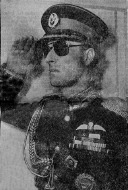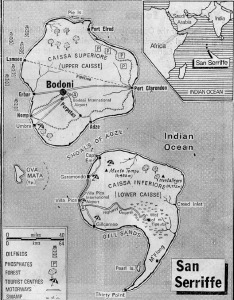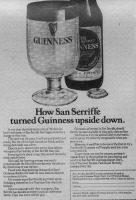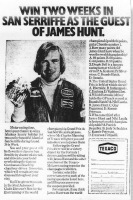On April 1, 1977 the British newspaper
The Guardian published a seven-page "special report" about San Serriffe, a small republic located in the Indian Ocean consisting of several semi-colon-shaped islands. A series of articles described the geography and culture of this obscure nation.
The report generated a huge response. The
Guardian's phones rang all day as readers sought more information about the idyllic holiday spot. However, San Serriffe did not actually exist. The report was an elaborate April Fool's Day joke — one with a typographical twist, since numerous details about the island (such as its name) alluded to printer's terminology.
The success of this hoax is widely credited with inspiring the British media's enthusiasm for April Foolery in subsequent years.
The seven-page San Serriffe supplement
The Creation of San Serriffe
Philip Davies, who was in charge of the
Guardian's Special Reports department, came up with the idea of an April Fool's Day feature about a fictitious island state. "Special Reports" were sections of the paper occasionally given over to exploring a subject (such as a country or a technology) in depth. Typically the subjects were quite dull, but lucrative from the newspaper's point-of-view since they were designed to attract related advertising.
Davies conceived of a special report about a fictitious island as a parody of the genre. He was later quoted as saying, "The
Financial Times was always doing special reports on little countries I'd never heard of. I was thinking about April Fool's Day 1977 and I thought: why don't we just make a country up?"
Davies approached the other editors at The
Guardian, and they enthusiastically embraced the concept. One of its great selling points was not only that it would be a funny joke, but also that it would be possible to get advertisers to play along. In other words, the spoof special report could make The
Guardian a lot of money.
Davies had imagined a small, one-page feature, but the other editors, realizing the potential, decided to expand it into a seven-page supplement, making it the largest special report the
Guardian had ever published.
Geoffrey Taylor was given the task of editing and designing the feature. He enlisted a crew of other writers, including Mark Arnold-Forster (writer of
The World at War TV series), Tim Radford, and Stuart St. Clair-Legge. St. Clair-Legge came up with the idea for the name "San Serriffe," which then inspired further typographical allusions. St. Clair-Legge also wrote the synopsis from which the spoof was developed.
The
Guardian turned to the advertising agency J. Walter Thompson to find companies willing to participate in the hoax. This proved to be an easy job.
The Special Report
The special report, when it was completed, consisted of seven pages, four of which were devoted to ads. Articles, written in a quasi-serious style that parodied the prose of special reports, examined the history, culture, and economy of San Serriffe.
The supplement commenced with an introduction by Geoffrey Taylor:
The ten years of independence which San Serriffe celebrates today have been a period of economic expansion and social development probably unrivalled by any other new nation. With this achievement has gone a determined attempt, in part successful, to maintain the outward forms of a parliamentary democracy. This special report, edited and introduced by Geoffrey Taylor, attempts to recount the remarkable transformation in the life of the Republic, to inform British investors and visitors of the opportunities which have been and are being created, and not least to encourage companies trading with the Republic to call attention to their share in its development. Rapid growth brings its own problems, not all of which can be solved in total composure. The survey allows some of those problems to be brought under closer scrutiny.
Articles included:
"Three point key to prosperity" by Geoffrey Taylor, which described how San Serriffe's economy had boomed thanks to the phosphate industry, tourism, and oil.
"The block vote which resulted in industrial peace" by John Torode, which discussed San Serriffe's unique solution to union/management cooperation -- all collective agreements on the island expire on the same day each year and are personally renegotiated by Antonio "Che" Pica, second cousin of the President.
"The leader's rise to power" by Mark Arnold-Forster, which discussed how Maria-Jesu Pica, San Serriffe's young President-for-life, came to power following an almost bloodless coup on May 11, 1971.
"Bold expansion in tourism" by Adrienne Keith Cohen, which discussed the many tourist attractions of San Serriffe, including a diverse mix of cultures, modern highways, air-conditioned hotels, and beaches "from which terrorism has been virtually eliminated."
"Transposed by the tides" by Anthony Tucker, which discussed San Serriffe's unique geological characteristic -- the constant eastward movement of the islands caused by tidal erosion.
"Casting off into unknown wealth" by Victor Keegan, which discussed San Serriffe's transformation from a small agricultural economy into an industrial steel-exporting force to be reckoned with.
"Spiking the cultural roots" by Tim Radford, which discussed the cultural heritage of San Serriffe's indigenous people, the Flongs, focusing on their unique celebration, the Festival of the Well Made Play. During this festival "local committees of Flongs and islanders of European extraction combine enthusiastically to mount the complete cycle of plays by William Douglas-Home in English, Caslon, and Ki-flong."
Sidebars in the supplement included "Guide to the Republic" and "Landmarks in History." These offered brief details about San Serriffe's demographics, geography, and history.
San Serriffe Geography

Bodoni, capital of San Serriffe
According to the supplement, San Serriffe was an archipelago located in the Indian Ocean, north-east of the Seychelle Islands. It consisted of two primary islands, Upper Caisse and Lower Caisse. The capital, Bodoni, was located in the center of the larger island, Upper Caisse. The smaller island, Lower Caisse, had a swampy interior as well as a forested area, the Woj of Type (home of San Serriffe's national bird, the Kwote).
Geoffrey Taylor designed a map of San Serriffe, based on the islands of New Zealand. His map shows the islands forming a semicolon shape.
The most singular feature of San Serriffe's geography was its mobility. Due to a constant process of erosion that removed sand from the west coast and deposited it on the east coast, the islands were moving eastward at the rate of 1400 meters a year. It was anticipated that the islands would collide with Sri Lanka in 2011. To slow down this movement, boats constantly ferried sand from the east coast back to the west.

Diagram of San Serriffe sand erosion
The idea to make San Serriffe an itinerant island chain came about by accident. Initially the
Guardian staff had located San Serriffe in the Atlantic, off the Canaries. But on March 27, two jets collided in the fog at Tenerife Airport, causing the death of 583 people. Sensing that it would be in bad taste to locate their spoof island in the region of this disaster, the
Guardian staffers moved the islands, at the last minute, to the Indian Ocean. This relocation inspired the idea that the islands should be migratory.
In subsequent years, the shifting location of San Serriffe became a running gag in The
Guardian. The island would reappear in different locations, popping up in the South China Sea, and even the Atlantic.
The spelling of San Serriffe also became a recurring joke, since it rarely followed any consistent pattern. Spellings of the name included San Seriffe, San Serriffee, and San Serriff.
San Serriffe Culture

General Pica
The origin of San Serriffe's indigenous people, the Flongs, was regarded as a mystery. Ancient inscriptions written in their language, Ki-flong, suggested they may have come from Brazil, before the movement of the islands eventually brought them to the Indian Ocean. However, "the Flong language may have been modified in relatively recent times during the transit of the islands round the African coast." The Flongs practiced a number of colorful rituals, including the Galle sect stamping, the Dance of the Pied Slugs, and the Festival of the Well Made Play.
The islands were colonized by the Spanish and Portuguese in the fifteenth century, before being annexed by Britain in the seventeenth century. The supplement described continuing "antagonisms between descendants of the original Spanish and Portuguese
colons and those of the later English arrivals, sometimes humorously derided as the semicolons."
San Serriffe achieved its independence from Britain in 1967. It was then ruled by a succession of dictators (Colonel Hispalis and General Minion) before General M.J. Pica assumed control of the government in 1971.
The discovery of oil in 1971 brought large amounts of money into the economy, and sparked rapid industrialization. By 1977 the inhabitants of San Serriffe enjoyed the highest per capita income in the world. The island's currency was the Corona.
In 1977 the population stood at 1,782,000, consisting of Europeans, Flongs, Creoles, Malaysians, Arabs, and "a leavening of Chinese".
San Serriffe Advertisements
Four out of seven pages in the San Serriffe supplement consisted of advertising. The presence of these ads by major corporations added a strong element of credibility to the supplement. Many people considered these ads their favorite part of the supplement, since all the advertisers played along with the joke in humorous ways.
Advertisers included:
Guinness, who described how the San Serriffe version of their stout was upside down. "How San Serriffe turned Guinness upside down: It was after the freak barley crop of '56 that the local inhabitants of San Serriffe first began to notice a change in their beer. The taste was the same. It still poured slowly and evenly. But the white head turned out black, and the strong dark body was white. Experts put it down to the novice farm helpers who spent their holiday in San Serriffe that year. Knowing little about crops, they sowed the barley seeds upside down."
Texaco, who offered racing fans a chance to win a vacation on San Serriffe's Cocobanana Beach. "Win two weeks in San Serriffe as the guest of James Hunt: Motor racing fans, here's your chance to win a fabulous luxury holiday for two on the beautiful island of San Serriffe during Grand Prix Week. You and your guest will be flown first-class to San Serriffe by chartered aircraft, and driven to your hotel overlooking the famous Cocobanana Beach."
Kodak, who ran a competition for the best photographs of San Serriffe. "If you've got a photograph of San Serriffe, Kodak would like to see it: ... Kodak are looking for photographs taken by amateur photographers which truly reflect the evanescent beauty of these fabulous islands. They will be collected together to form an Exhibition, entitled "The Legendary Beauty of San Serriffe," which will be mounted at this time, next year."
Vladivar Vodka ran an official greeting from the "People's Republic of Warrington," where their drink was distilled.
The
Guardian itself invented a fake ad, inviting applicants for the position of Reader in Lunar Spectroscopy at the University of San Serriffe. "Department of Lunar Studies: A vacancy will shortly exist for a Reader in Lunar Spectroscopy. With special emphasis on the extraction of energy from moonbeams. The post is tenable from October 1st, 1977, at a salary in the range SSCorona 5,650-7,100. (At present exchange rates C1 — £4.30 sterling). Free housing and use of outrigger." Many people sent in their CV. One applicant began his letter, "Although not a lunar spectroscopist..." and proceeded to ask if any other positions were available.
The Response
The San Serriffe supplement generated an enormous reponse. The
Guardian reported that its phones rang all day as people called up requesting more information about the island. Later hundreds of letters arrived. One of these was from a group calling itself the San Serriffe Liberation Front, who took the newspaper to task for the pro-government slant of its report.
David McKie, remembering the hoax in a 2006 article in the
Guardian, wrote:
The impact of the seven-page survey was quite astonishing. The office all day was bedlam as people pestered the switchboard with requests for more information. Both travel agencies and airlines made official complaints to the editor, Peter Preston, about the disruption as customers simply refused to believe that the islands did not exist. Veterans of that time say there's never been a day like it in terms of reader response. Over the past 30 years, San Serriffe has entered the language as a kind of flawed utopia and one American writer has published a series of erudite books about its publishing industry. Geoffrey Taylor now lives in New Zealand, and messages reaching the Guardian early this morning suggest that San Serriffe is floating today just off the South Island.
The
Guardian also sold "I've been to San Serriffe" bumper stickers and 12,000 San Serriffe t-shirts.
The success of the hoax is widely credited with inspiring the flood of April Fool's Day jokes that appeared in other British papers in succeeding years.
The Sequel
On April 1, 1978 the
Guardian published a San Serriffe sequel. This consisted of ten pages of spoof front pages from San Serriffe newspapers, syled after the leading British papers. The SS Sunday Times, News of the SS World, SS Irish Times, SS Telegraph, SS Times, SS Morning Star, SS
Guardian, and SS Financial Times each got a full page. The tabloids (SSun, SS Express, SS Mirror, and SS Daily Mail) got half a page each.
The style of this predecessor was more slapstick than its predecessor. It was generally felt to be less successful than the original
The
Guardian never again devoted a full supplement to San Serriffe. However, in later years it did publish articles about the island state. Most notably, the April 1, 1999 edition of the
Guardian featured "Return to San Serriffe."
In this update, readers learned that in 1989 General Pica had been deposed by a cabal of senior officers, and in 1997 Antonio Bourgeois was swept to power in the island's first free elections.
Spinoffs
Since 1977, a large body of secondary material about San Serriffe has been created by fans.
• Brian Green created a Friends of San Serriffe club in Welwyn Garden City. He appointed himself as its "life president." In this role, he wrote a number of letters to the
Guardian, such as one in which he claimed that the island nation planned to boycott the Eurovision Song Contest because its entry, Pica Pica Boom Boom singing "Flongratulations," had apparently raised objections.
• A Texas Man created San Serriffe diplomatic plates for his car.
• A professor at Liverpool University invented San Serriffe -- The Game.
• Henry Morris, owner of the Bird & Bull Press in Pennsylvania, has published a series of books about San Serriffe, many of them under the name of his alter-ego, Theodore Bachaus. His books include: Booksellers of San Serriffe; First Fine Silver Coinage Of The Republic Of San Serriffe; and The World's Worst Marbled Papers: Being a Collection of Ten Contemporary San Serriffean Marbled Papers Showing the Lowest Level of Technique, the Worst Combinations of Colors, and the Most Inferior Execution Known Since the Dawn of the Art of Marbling Collected by the Author During a Five Year Expedition to the Republic of San Serriffe.
• David Hamilton wrote
The South-Sea Brithers: History of the San Serriffe Golf Club. This satirical work tells the history of the Great North Bodoni Railway Company golf club at Port Baskerville, San Serriffe.
• In 2006 the Wikitravel website published an April Fool's Day
article about San Serriffe.
San Serriffe Haiku (Submitted by Hoax Museum visitors)
Typesetters may dream
Of the idyllic landscape'd
Isles of San Serriffe
(by Paul)
|
Endless toil -- Boats haul
Sand from east to west, and yet
The island moves on.
(by AB)
|
Off in "San Seriffe"
the islands keep on moving
through imagined seas.
(by L.)
|
|
Links and References








Comments
At least back then, the world had true typographers... Now we have wanna be "graphic designers" who still wouldn't recognize a serif from a sans serif!
All in all a wonderful place to visit as it was always changing.
Oh and the artwork of the map which appeared in the supplement is in the British Musum cartographic hoaxes room, but no-one at the paper ever discovered how it got there...
Theres an article about its creator and a full page of example games played out move by move on Japanese type grids. Its tic-tac-toe. Brilliantly done. nearly 40 years on and still as daft!
http://www.guardian.co.uk/Columnists/Column/0,,1744581,00.html
including the air crash on Tenerife just before publication, which caused the islands to be moved from that area.
It took me about 2 pages before the penny dropped, not because of the printing terminology, but because of some of the other proclaimed 'facts'
My original idea was to take the mickey out of the FT who were publishing long reports on obscure emerging nations that nobody had ever heard of. So I decided to invent one of my own.
Peter Preston was editor at the time and it was his decision to run with it. It was almost pulled at the last minute because of the aircrash on Tenerife in which several hundred were killed. We thought it might be in bad taste.
JWT exclusively booked every advertisement that appeared. It was personally handled by their CEO.
The size of the report was governed by the value of ads booked.
We received 12,000 responses of one sort or another.San Serriffe received mentions in both the UK and European Parliaments.
Philip Davies
I think what Patricia O. was trying to say is not that Graphic Designers don't know typograpic terms these days; because that is why we still go to school for (I am a Graphic Designer myself and learned all that). I beleive she was referring to the people that are 'wanna be Graphic Designers' simply because they get a computer that allows them to choose typefaces and create home-made design; without the proper schooling.
The thing that gave it away was a job advertisement for (I think) Lunar Geologists, or something to do with the moon. The salary was advertised in the local San Seriffe currency (whatever that was) and elsewhere in the supplement it gave the exchange rate. If you did the maths the job paid about 150,000 pounds, a bit rich even for a Moon specialist in 1977.
best regards and congratulations
He's visible as one of the over-dressed bodyguards in full uniform in one of the original photographs of the President. (I wish I could find a copy online - if anyone knows of one, please reply to this message.)
I have just found a reproduction of the supplement on a blog by Michael John Smith.
It starts at http://parellic.blogspot.com/2006/11/san-serriffe-secrets-of-guardian-spy.html with a link to a scond part.
I hope you all enjoy it.
I enjoyed it so much I kept it, and still have it.
The only one I know which equalled it was an April fool item which appeared in a very small country newspaper in Australia during the 1960's.
The paper was the Macleay Argus ( Kempsey New South Wales), the editor - well, OK, they wouldn't let her be the editor because she was a woman, but she did all the work while the men did god knows what, printed that the Russians had landed at South West Rocks ( a local beach).
Half of the district drove towards the hills to escape from the Russians, while the other half drove towards the beach to see what Russians looked like.
Many years later she evidently said that neither group ever trusted her again.
My apologies for not being able to supply her name, although if anyone wants to know what it was I can find it out.
Mary, Sydney April 3rd 07
http://en.wikipedia.org/wiki/San_Serriffe
as does Wikitravel:
http://wikitravel.org/en/San_Serriffe
And this year The Guardian is offering the Guardian Book of April Fool's Day, which of course includes full details:
http://www.guardianbookshop.co.uk/BerteShopWeb/viewProduct.do?ISBN=9781845131555
I still have mine somewhere!
publication should any anyone want
it I'm open to offers It would be nice
for it to be appreciated